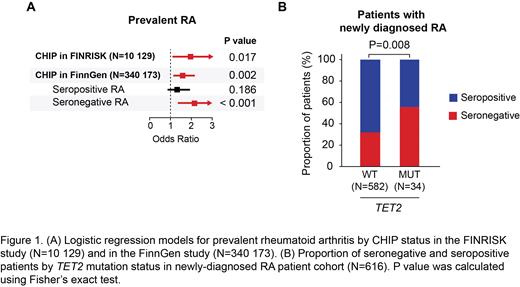Introduction: Clonal hematopoiesis (CH) becomes common with age and can play a role in the pathophysiology of inflammatory diseases by modifying immune cell function. CH is characterized by the presence of somatic mutations in genes such as DNMT3A and TET2 (CH of indeterminate potential, CHIP), and as mosaic chromosomal alterations (mCAs). While CHIP, particularly in the context of TET2 mutations, can promote inflammation in cardiovascular diseases, the association between clonal hematopoiesis and autoimmunity has not been comprehensively studied to date. Rheumatoid arthritis (RA) is one of the most common autoimmune diseases primarily affecting joints. Seropositive RA is defined by the presence of anti-cyclic citrullinated peptide antibodies (ACPA) and/or rheumatoid factor (RF), whereas seronegative RA is a more heterogeneous inflammatory disease entity involving patients with clinical RA manifestations in the absence of ACPA and RF. Understanding of the association between CH and inflammatory processes may yield novel insights into prevention and management of autoimmune diseases.
Methods: To comprehensively evaluate the association between CH and autoimmune diseases, we identified CHIP variants in whole exome sequencing (WES) data from the FINRISK study (N=10 129). We also detected mCAs and CHIP in the nationwide FinnGen study (N=340 173), where we manually identified CHIP carriers as outliers in SNP intensity plots at known CHIP loci in DNA microarray data. Only known CHIP loci with variant prevalence comparable to UK Biobank WES data and significant positive associations with age and hematological malignancies were included for downstream analyses. To further characterize the link between CHIP and RA phenotypes, we performed targeted panel sequencing of 69 myeloid driver genes in 675 RA patient blood samples (91% collected at diagnosis) and 60 healthy controls. We studied the association between CH and RA in multivariable models excluding participants with prevalent hematologic malignancies and adjusting for sex, age, smoking, and principal components of ancestry. We performed uni- and multivariable analyses to evaluate the link between CHIP and RA patient phenotypes.
Results: We identified CHIP in 381 (3.8%) FINRISK participants. As expected, the prevalence of CHIP increased with age, and CHIP variants were associated with prevalent and incident hematologic malignancies. C-reactive protein values were higher in participants with CHIP (P<0.001). In multivariable models, CHIP status (OR 1.98, 1.13-3.45, P=0.017) was more common in participants with questionnaire-based history of RA (N=151) (Fig 1A). In the FinnGen study, CHIP carrier status was associated with prevalent autoimmune diseases (OR 1.26, 1.05-1.53, P=0.015). We validated the association between prevalent RA (N=10 990) and CHIP carrier status (N=2 393) in the FinnGen study (OR 1.58, 1.18-2.13, P=0.002) (Fig 1A). In particular, CHIP (OR 2.17, 1.40-3.36, P<0.001), and GNB1 variants (OR 4.71, 1.87-11.82, P=0.001) were associated with the seronegative RA, whereas DNMT3A was associated with seropositive RA (OR 1.83, 1.08-3.09, P=0.024). We observed no association between autosomal mCAs and RA.
Using targeted panel sequencing, we found CHIP in 22% (146/675) of RA patients. RA patients with CHIP variants were older than those without a CHIP variant (median, 69 vs 63 years, P<0.001). Erythrocyte sedimentation rate (ESR) was higher in those with CHIP (median, 42.5 vs 26.0 mm/h, P=0.043). RA patients with TET2 variants were more likely to have seronegative disease compared with TET2 wild-type patients (proportion of seronegative patients, 56% vs 33%, OR 2.62; P=0.008) (Fig 1B). The association remained significant (OR 2.38, 1.14-4.96, P=0.02) when adjusting for age, sex, and smoking. Evaluation of longitudinal disease outcomes by CHIP status are currently ongoing.
Conclusion: CHIP variants were more common in participants with prevalent RA in two population-level cohorts, and the association was specific to seronegative RA in the large FinnGen cohort. In newly diagnosed RA patients, TET2 mutations were more common in seronegative than in seropositive RA. While the causality and the functional basis of these observations remain to be explored in future studies, our results provide additional evidence for the association between CHIP and inflammation in various disease contexts, including autoimmune diseases.
Disclosures
Kauppi:Novatris: Membership on an entity's Board of Directors or advisory committees; UCB: Consultancy; Pfizer: Consultancy; Abbvie: Consultancy, Membership on an entity's Board of Directors or advisory committees. Mustjoki:Pfizer: Research Funding; BMS: Honoraria, Research Funding; Novartis: Honoraria, Research Funding; Dren Bio: Honoraria. Myllymäki:Gilead Sciences: Research Funding; Sanofi: Honoraria; Celgene: Honoraria.


